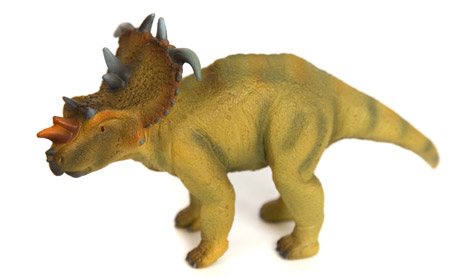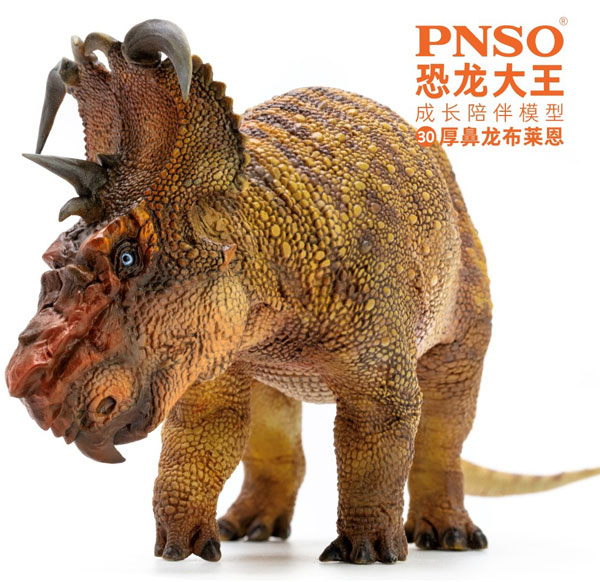New Species of Pachyrhinosaurus named in honour of Discoverer
The Ceratopsidae were perhaps the last large group of dinosaurs to evolve. Some of these horned dinosaurs are extremely well known, for example, Triceratops is one of the most popular of all dinosaurs and thanks to the many bone beds discovered, scientists have many fossils of animals such as Centrosaurus and Pachyrhinosaurus to study.
However, a new species of Pachyrhinosaurus has just been named in honour of the teacher who was the first to find fossil bones representing this new species of centrosaurine. Al Lakusta, a local science teacher often took his class out into the countryside of Alberta as part of his teaching programme, helping to enrich lessons in class with practical illustrations from the many geologically important sites in northwest Alberta.
Pipestone Creek, was one such location visited by Mr Lakusta and his classes but on one occasion he ventured further up the creek bed than previously and discovered parts of an exposed dinosaur bone bed, that proved to be a new species.
The new species of Pachyrhinosaurus has been named Pachyrhinosaurus lakustai. It is a great honour to have a dinosaur named after you, few people have been awarded this accolade and those that have been are usually awarded this posthumously. The now retired teacher, a resident of Grande Prairie, Alberta will be remembered in palaeontological circles, not only as the new species has been named after him but the quality of the bonebed he discovered will provide scientists with resources to work with for many years to come.
It seems that approximately 72.5 million years ago a disaster overcame part of a herd of these giant, horned dinosaurs and they were buried. Many of the fossils represent complete specimens, 27 individual dinosaurs have been identified so far. The bone bed represents adults and juveniles and such a resource will help palaeontologists understand better the ontogeny of this species as well as clarify differences between the sexes.
These dinosaurs also had large bony structures above their nose and eyes, which lends them their name: Pachyrhinosaurus (thick-nosed lizard).
These structures probably supported horns of keratin, said researcher Philip Currie, Canada research chair of dinosaur palaeobiology at the University of Alberta, who was involved in the excavations and is one of the most prominent scientists working on the Alberta finds.
The new species of Pachyrhinosaurus is closely related to Pachyrhinosaurus canadensis, which is known from younger rocks near Drumheller and Lethbridge in southern Alberta, Currie said. This is only the second species of Pachyrhinosaur to be described to date. The new found species is a smaller animal with many differences in the ornamental spikes and bumps on the skull.
The adults of both species have massive bosses, or protuberances, of bone in the positions where other horned dinosaurs (like Centrosaurus and Triceratops) have horns.
However, juveniles of the new species resemble juveniles of Centrosaurus in having horns rather than bosses.
An Illustration of Pachyrhinosaurus

Picture credit: Everything Dinosaur
“The density of the Pipestone Creek bone-bed is exceptional and surpasses many of Alberta’s other Ceratopsian bonebed sites,” Currie said. “The preservation of the material is outstanding and was easy to collect. The number of bones, from all age groups, made complex investigations possible regarding behaviour and growth patterns.”
With this new species, researchers will now have more data to give a better understanding of the ancient life and ecosystems in north-western Alberta in the Cretaceous period, Phil Currie added.
It has been estimated that this new species of Pachyrhinosaurus grew to a size of around 5-6 metres and it is hoped that the extensive remains of many individuals in what was probably a herd structure, may provide new insights into these animal’s social structure and herding behaviour. The pachyrhinosaurs are quite common fossils in the Drumheller area, indeed a group of life-size models of this dinosaur used to adorn the front entrance to the Royal Tyrrell museum in Drumheller.
PNSO recently introduced a highly-detailed Pachyrhinosaurus model, to view the range of PNSO models and figures: PNSO Prehistoric Animal Models.







Leave A Comment